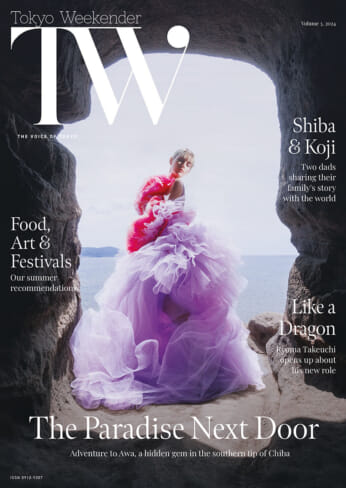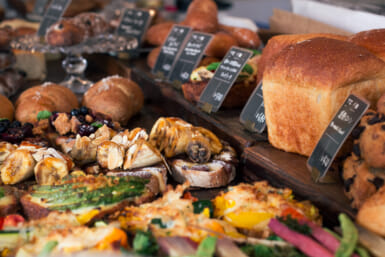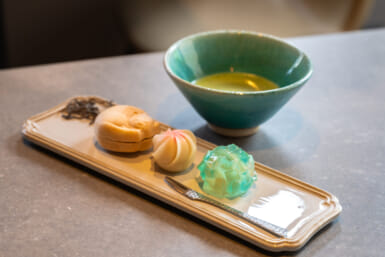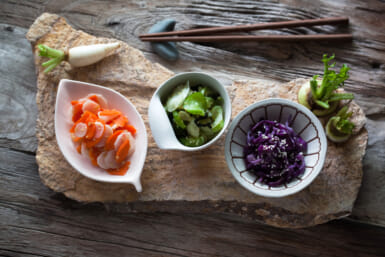by Susan L. Scully
Apprehensive. Yes, that’s what I was. Me, an unreconstructed carnivore, a dedicated meat ‘n’ ‘taters devotee, on my way to eat a health food lunch. No doubt, thought I, the meal would be an unappetizing hodge-podge of unidentifiable squigglies, slimy seaweed, chewy gray gelatinous matter and ersatz meat.
Ersatz meat. Yes, I remembered it well from my third or fourth grade days when I went to visit a friend, a boarding student at a Seventh Day Adventist elementary school. The Adventists, if they are strict, are vegetarians. The school was strict. And I can still conjure up in my gustatory imagination the slightly sulfuric taste of the “hamburger” I was served there.
Imagine my surprise then when, for lunch at the Hakumon Restaurant near Awajicho and Chuo University, I dug into a very tasty “meat”-stuffed green pepper garnished with cottage cheese made from soybean milk; miso soup; and brown rice sprinkled with a zesty combination of sea salt and toasted sesame seeds.
Gluten meat’s come a long way, baby. And the health food movement has reached Japan (there are now some 150 stores and several restaurants in Tokyo), probably to stay until yet another diet fad takes its place.
I use the term “fad” advisedly and without the usual pejorative overtones. People are fickle, especially so about what they eat. We all, for example, know people who are grossly overweight and know it, but just can’t stick to a sensible regime long enough to remedy the situation. And ultimately, even though people may know that animal proteins, preservatives and chemicals aren’t likely to promote health and longevity, most folks will probably end up eating what tastes good anyway.
There is considerable controversy and a good deal of illogic surrounding the health food movement. Proponents of its tenets hold that 1) it has been amply proven by the medical profession that animal protein is not only harmful to the human mechanism, but unnecessary. And that 2) nature’s way is best.
Individual applications of health food theories vary, but they are overwhelmingly vegetarian and range from regimes that include meat substitutes as a sort of compromise for the real thing to macrobiotic master Georges Ohsawa’s famed number 7 diet, which consists of cereals and cereals only. Foods produced artificially or grown with chemical fertilizers are shunned, as are fruits and vegetables out of season or natural habitat.
Opponents of the health food wave point out that yin/yang guru Ohsawa is said to died of malnutrition along with several of his disciples; claim that plants can’t tell whether fertilizers are produced in factories or come from natural sources; and that Western nutritional traditions that seek to balance consumption of meat, poultry and fish with dairy products, grains, fruits and vegetables, have produced the physically superior races of the world.
The health food people counter with the argument that of the human animal’s 32 teeth, eight are incisors for cutting and slicing vegetables, 20 (or five-eighths of the total) are molars designed for grinding cereal grains, while only four (or one-eighth) are canines whose function is tearing meat. And if that’s the way Mother Nature designed us, that’s the way we should eat.
There is probably merit in both arguments, and if you wish to explore an alternative to the traditional European-type diet, the availability of health foods in Tokyo is no longer the problem it was several years back. In almost every part of town, a store specializing in natural food products can be found; subsections in supermarkets and department stores are opening regularly; and there is at least one natural food restaurant with an extensive and tasty choice of dishes.
What, then, are the staples of a health food diet? What should you look for? The soybean, as high in protein content as most meats, is one. From it come tofu, miso (used mainly for soups) and milk (which can be consumed as is or used in such products as ice cream and cottage cheese). Unpolished grains—whole wheat, brown rice—represent another staple. Unpolished, because the majority of vitamins and minerals are said to be contained in the husk. Germ, wheat and rice, the most nutritious part of the grain, which can be eaten by itself as a cereal or added to other foods to increase their nutritive value. Condiments are in the form of natural sugars (various types of honeys, for example), non-dairy butters (peanut, sesame, almond, cashew, sunflower), sesame seeds.
There are any number of other products available at Tokyo health food outlets. But perhaps the best method of going about choosing those you need is first to find a diet that suits you—either through your doctor or from a reputable nutritionist. Then go to a store, look and inquire about the products stocked there. Then, buy, try and experiment.
Of all the health food stores in Tokyo, there are three in particular that are highly recommended. The first is the Shizenshoku Center on Ginza-dori just below Shimbashi (3-26-3 Shim-bashi, Tel. 573-4181). Here, along with the standard selection of staples, we found an exceptional variety of honeys—our favorite, one with ginseng and lemon rind. A very small snack bar is attached to this shop.
The second is the Shizenshokuhin Center, on the road that lines the right side of the Yamanote tracks going from Shibuya to Ebisu (Sakuragaoka, Shibuya-ku, Tel. 461-7988). Somewhat larger than the Shimbashi establishment, this store has a good selection of whole wheat breads and pastas, as well as a small book section with English works on health foods and methods of preparing them. The attached Tenmi (Heavenly Taste) Restaurant, which was a strictly macriobiotic eating spot, is being closed, but the shop is still in operation.
And, finally, a very extensive menu of natural food dishes is available at the above-mentioned Hakumon Restaurant, near Awajicho (3-1 Surugadai, Kanda, Tel. 291-9762), as well as a limited variety of products on sale for use at home. Chef Shinoda, who marshalls forces in the Hakumon kitchen, was trained at Tenmi and we can vouch for his skill. And even though it’s somewhat off the beaten track, the Hakumon offers English-speaking advice on health foods and related matters from its genial young French manager “Jimmy” de Jeammes. And, in these days of galloping inflation, very reasonable prices, too.








